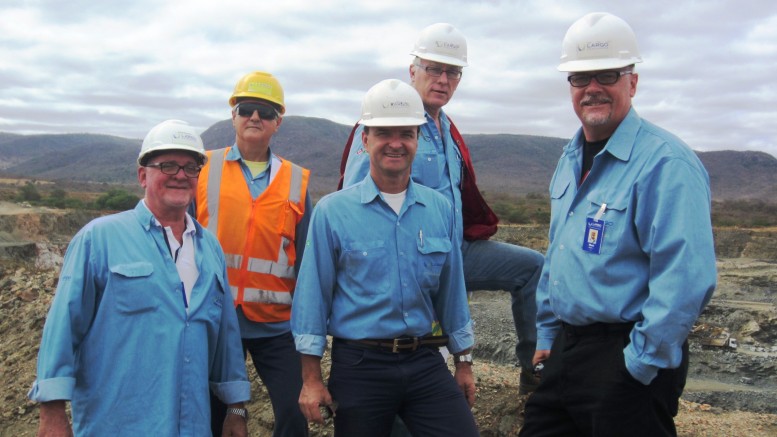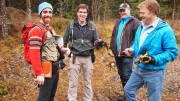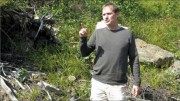MARACAS, BRAZIL — About an hour’s drive from Maracas — the city of flowers — is the first producing vanadium mine in Brazil’s northeastern state of Bahia. Toronto-based Largo Resources’ (TSX: LGO) Maracas Menchen is also one of the world’s newest vanadium mines.
The Maracas property lies about 250 km southwest of Bahia’s capital, Salvador, the vibrant centre of Afro-Brazilian culture. From Salvador, nicknamed the land of happiness, the distance to the project is 405 km via a paved secondary road. That includes the 50 km from Maracas.
The landscape varies from low mountains to flat plains during the five-hour drive from Salvador’s international airport. We pass Feira de Santana, Bahia’s second-largest city after Salvador, and traverse several smaller cities, slowing down by the geomorphological rock site in Itatim. Night falls as we reach the rustic town of Maracas.
Early the next morning, we head to Largo’s flagship asset. Maracas Menchen hit commercial production in October 2014, and recently ramped up to full production of 800 tonnes a month, or 9,600 tonnes vanadium pentoxide (V2O5) a year.
“We have the highest ore grade and the highest concentrate grade of any known vanadium producing facility in the world,” Mark Smith, Largo’s CEO and president, says during a mid-June presentation at the site.
Reserves at the main Campbell pit total 18.4 million tonnes grading 1.2% V2O5. That’s more than double the industry’s average.
Based on Largo’s 2016 reserve estimate and new mine plan, Maracas Menchen can deliver 9,600 tonnes annually over a 15-year life. The ore contains 29.5% magnetics (magnetite), yielding an average concentrate grade of 3.3% V2O5.
Largo is guiding 2016 production of 7,639 tonnes to 8,639 tonnes (16.8 million to 19 million lb.). Average cash-operating costs should come in at US$3.71 per lb., based on a Brazilian real to U.S. dollar exchange rate of 3.59.
In June, the mine churned out a high of 801 tonnes, surpassing its May production of 780 tonnes. Unit production costs were US$3.54 per lb., while the real/U.S. dollar exchange rate was 3.42.
With the improved vanadium price, trading mid-June at above US$4 per lb., Maracas Menchen is getting closer to turning a profit.
“We are on the cusp of it right now because our costs are actually better than we had projected in our budgets and forecast … the price is now giving us a 50¢ to 60¢ cushion, in terms of being higher than our unit cost of production,” Smith says.
Without specifying when Maracas Menchen would generate cash, the executive says it should happen soon. “I can taste it. That is how close we are.”

The Campbell pit at Largo Resources’ Maracas Menchen vanadium mine in Brazil. Credit: Salma Tarikh.
Largo has spent a decade transforming the Maracas property into a high-quality vanadium producer.
It started its journey in October 2006, signing an option agreement with Brazilian companies Vale (NYSE: VALE) and Odebrecht to acquire 90% of the Maracas property for US$10 million.
Before Vale and Odebrecht’s involvement, geologists at state-owned Companhia Baiana de Pesquisa Mineral (CBPM) discovered the vanadium-rich titaniferous magnetite occurrence in 1980 on what’s now part of the Maracas property, while exploring the Rio Jacare mafic to ultramafic intrusion. It drilled 1,100 metres in 14 exploration holes.
Four years later, CBPM formed a joint venture with Odebrecht. Between 1984 and 1987, the private engineering firm systematically explored the property, completing another 4,020 metres in 39 holes.
In 1990, Odebrecht created a new joint venture with Caemi (now Vale) and completed engineering studies in the following years, with an aim to build a mine. That never happened due to low prices.
Around this time, “the [Berlin Wall] came down and Russia needed money, and was selling everything. And metal prices went right into the toilet,” Andy Campbell, Largo’s vice-president of exploration, says. “The project was put on hold.”
In 2005, Campbell made his first visit to the property. (Largo at that time was exploring a gold project in Ecuador.)
“This was all grasslands for cattle,” the Canadian geologist recalls, gesturing at Largo’s towering processing facility. “From here all the way out there,” he points to the horizon.
Campbell reveals he initially liked the Maracas property because the historic database indicated high vanadium grades and platinum group elements. “I thought, ‘Wow, this will be interesting, I got platinum and vanadium.’ And this vanadium is very high grade. So that was what intrigued me.”
Campbell recommended the project to Largo’s former president and CEO Mark Brennan. From there, he led the validation of the database using modern techniques, noting the results came back “dead on.” This helped him put together a model and resource estimate in November 2006, a month after Largo signed a 90% option on the Maracas project. The junior bought the remainder in December 2012 for US$8 million.
From 2007 to 2015, the company, focusing solely on vanadium, ran various exploration programs, including 1,000 line-kilometres of line cutting, ground magnetics, induced polarization and lithogeochemical studies. It drilled 35,682 metres in 256 holes, with most of the holes concentrated on the Campbell pit (named after Andy Campbell).
The pit outline extends 400 metres along strike and to a vertical depth of over 350 metres. Largo plans to mine the pit down to 300 metres. There are another five satellite deposits on the 285 sq. km property.
Largo applied for its first permits in 2010 and began construction in June 2012.
Start-up capital for the mine came in at US$248 million, largely in-line with the original estimate. First V2O5 production kicked off in August 2014.
Smith became Largo’s president and CEO in April 2015, after Brennan retired. The engineer by training held the same position at Molycorp, a rare earth metals miner, from 2008 to 2012. He also runs NioCorp Developments, which is developing a niobium-scandium-titanium project in Nebraska.
Smith recalls that the moment he walked into the door at Largo, he started raising money to alleviate the company’s cash crunch from the slow ramp-up at Maracas, lower metal prices and looming debt payments.
He spearheaded a $75.2-million private placement last May, and renegotiated the debt package with Maracas’ lenders, including Brazil’s Development Bank and commercial banks Itau, Votorantim and Bradesco.
In March 2016, Largo reworked the terms with its lenders again to waive all repayments due this year. It also raised another US$26.8 million ($36.6 million) in a non-brokered private placement, with its largest shareholder Arias Resource Capital Management LP. Through that financing, the New York-based private equity firm pushed its 46.3% interest in Largo to a little under 60%.
The latest financing should cover all of Largo’s expenses for this year, Smith notes, adding he is always looking to raise more funds. “If we raise capital right now, it will simply be to provide a cushion for our treasury. It is not because we are in dire need for capital.”
Breaking rock
Back at the office, Campbell points at a slide with a cross section of the main pit. “It’s really simple geology,” he says. The Jacare layered sill — which covers the 40 km strike length of the Macaras property — contains mostly gabbros and lesser amounts of pyroxenites, anorthosites and magnetite bodies.
The magnetite has 97% of the vanadium and occurs as massive and banded magnetite, and the magnetite pyroxenite in the deposit.
The massive magnetite contains more iron ore and vanadium than the magnetite pyroxenite. As a result, it is heavier and more magnetic.
Campbell pulls out a pen to show how a sample of massive magnetite attracts its metal tip.
Largo uses a team of hydraulic excavators, large front-end loaders and 40-tonne haul trucks to extract the magnetite ore.
The ore goes through a relatively complicated process to produce V2O5 flakes, starting with three stages of crushing followed by dry magnetic separation.
“The neat thing about this is the magnetics [magnetite] is in layers,” Campbell enthuses. The dry mag segregates the magnetic part of the material from the waste. “Obviously, because the vanadium is in the magnetics, your grade goes up.”
This enables Largo to reject up to 40% of the material, before running it through the mill, followed by wet magnetic separation and filtration to create concentrate grading above 3% V2O5. From there, a conveyor system adds sodium sulphate and sodium carbonate to the concentrate before sending it into a 90-metre long kiln, responsible for roasting the materials at 1,100°C.
Inside the kiln, which is described as twice as hot as the surface of the sun, the vanadium oxidizes and becomes attracted to the sodium, and turns into a soluble salt.
Next it is cooled, regrinded and leached. It is at this stage that vanadium becomes a liquid, Paulo Misk, Largo’s president of Brazil operations, points out.
The “liquid vanadium” goes through filtration and desilication to lower the silica content. Largo then uses ammonium sulphate to precipitate the vanadium into a solid again. After flash-drying and removing ammonium, it produces V2O5.
In the last step, Largo melts the V2O5 in another furnace and pours the melt onto a wheel, which produces the flakes. It then packs the flakes.
Glencore International (LSE: GLEN) picks up all the flakes three times a week from site under a six-year, 100% off-take agreement. The contract has four years remaining.
While pleased to have Glencore as a partner to market the product, Smith points out that Glencore only needs the V2O5 to be 98% pure, and pays market price for that.
This doesn’t reflect the value of the quality of Largo’s 99.5% V2O5 product, Smith says. “And we think it deserves a better price.”
But he notes there has been much interest for the company’s high-quality vanadium from producers, including Japanese steelmakers and vanadium redox battery-makers.

Largo packs the vanadium flakes in drums and bags. Credit: Salma Tarikh.
V is for vanadium
Vanadium is the twenty-third element on the periodic table. Spanish-Mexican mineralogist Andres Manuel del Rio Fernandez first discovered it in 1801 and named it erythronium, but dismissed it, thinking it was impure chromium. Swedist chemist Nils Sefstrom rediscovered it in 1830, and fittingly called it Vanadis, after the Scandinavian goddess of beauty. Oxidized vanadium undergoes colour changes when shaken with a zinc-mercury amalgam.
The yellow solution turns green, blue and purple, as zinc adds the electrons back into vanadium.
In its solid form, vanadium is a silvery-white ductile metal. The two saleable vanadium products are ferrovanadium, which makes 90% of the market, and vanadium pentoxide flakes. (Users can convert flakes into ferrovanadium by adding iron.)
Most of the vanadium produced goes into steel as an alloy, making the steel stronger, lighter and more durable.
“Adding 500 grams of vanadium to a tonne of steel could increase the steel’s strength by up to 40%,” Misk adds.
The main source of vanadium is layered mafic to ultramafic intrusions. It could also occur in sediment-hosted deposits and be mined as a by-product in fossil fuel and uranium mining.
Some significant vanadium producers include primary producers Maracas and Glencore’s Rhovan operation in South Africa and co-producers Kachkanar in Russia and Panzhihua in China.
In 2014, the world’s three top vanadium suppliers were China, with 53%; South Africa, 20%; and Russia, 17%. Others accounted for the remaining 10%.

Largo’s processing plant at the Maracas mine. Credit: Salma Tarikh.
The global supply in 2014 was 95,000 tonnes. Largo’s CEO reckons supply should be 15,000 to 20,000 tonnes less this year, given the recent slump in vanadium prices, which sank to US$2.40 per lb in December 2015. This resulted in bankruptcies in South Africa, steel furnace shutdowns in China and the Chinese importing iron ore for their steel production, as iron ore prices also were pummelled.
About 64% of vanadium’s global supply is a co-product of iron ore, with China being the largest co-producer. “The problem is that now, iron ore prices have come down so badly, they can’t sell this stuff because it is too expensive,” Campbell says.
Iron ore mined in China costs US$125 per tonne, exceeding the spot price of US$52 per tonne. Due to expensive domestic production, Chinese steelmakers have been importing seaborne iron ore from Brazil and Australia, which costs US$50 per tonne to produce.
Largo says that as China imports more iron ore, its coproduction of vanadium should drop.
Looking at vanadium consumption, 91% of the vanadium produced goes into steel production, of which half goes into creating high-strength low alloy (HSLA), where demand is growing.
“Although the steel market in general doesn’t feel healthy right now, specialty steel is a high-growth area,” Smith says.
The demand for HSLA steel, mainly vanadium and niobium, is growing in the automotive and aerospace industries.
“Twenty years ago there was zero percent HSLA steel used in the production of automobiles. Today about half of the steel that goes into automobiles is HSLA. Experts suggest that within three to five years it will go up to 80%,” Smith says, driven by the need to make cars more fuel-efficient by making them lighter.
Largo notes that aircrafts account for 7% of the vanadium market and that figure is rising, as aircraft manufacturers use higher amounts of titanium-vanadium alloys in newer models.

A miner at Largo’s Maracas Menchen operation in Brazil. Credit: Salma Tarikh.
While vanadium redox batteries make up a small percent of the market, Smith predicts it will represent the largest growth area for vanadium in the future, as solar and wind operations become more prevalent.
“We always want power when the wind isn’t blowing and the sun isn’t shining. And of course, it is hard to generate power in those times. So when the wind is blowing and the sun is shining, you want to generate as much power as possible. That power is stored in these vanadium redox batteries,” Smith says.
Given the estimated uptick in demand and decrease in supply, Largo projects a deficit in the vanadium market should emerge in 2018, as supply fails to meet demand. This should help push up the vanadium price near US$5 per pound.
But for now, Largo is focused on sustaining the mine’s production rate, bringing down costs and improving safety. The company is the region’s largest employer, with 303 employees and 280 contractors. The employees reside in Maracas, with Largo bussing them from the town to site.
After the tour of the Maracas Menchen operation, Smith reveals that “people always ask me what I like about Brazil, and I tell them: the people. They are warm and friendly, and if you give them the resources, they will do their best. It’s all smiles here.”
Largo shares closed July 8 at 44¢, within a 52-week range of 11¢ to 80¢.






Be the first to comment on "Site visit: Largo is ‘all smiles’ in Brazil"